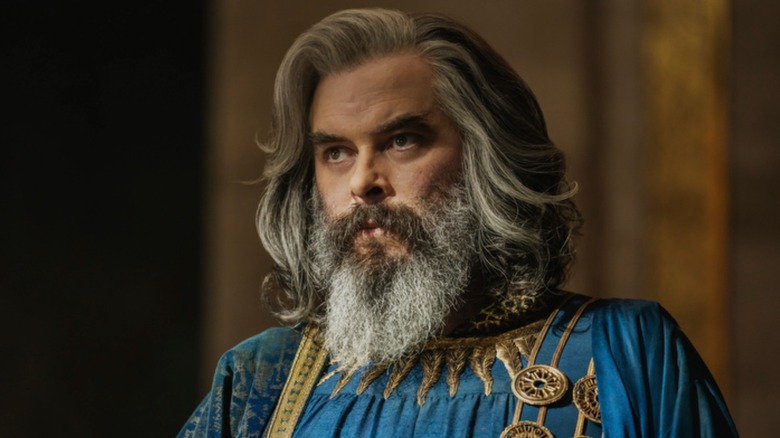How The Rings Of Power Season Finale Sets Up The Black Númenóreans
Earlier this week, "The Lord of the Rings: The Rings of Power" co-showrunner Patrick McKay spoke to The Hollywood Reporter, revealing that season 2 of the series is set to adapt a story about Sauron (Charlie Vickers) that comes straight from the Tolkien canon. While the writer-producer stayed mum on the details about which story he and J.D. Payne will be bringing to audiences when the show returns, we have a pretty good guess: the rise of the Black Númenóreans, which coincides with the eventual fall of the great city.
There are plenty of hints throughout this season that "The Lord of the Rings: The Rings of Power" is headed toward an adaptation of Akallabêth, the section of "The Silmarillion" that tells the story of Númenór's downfall. After all, the king who dies in the finale, Tar-Palantir (Ken Blackburn), is known as the second-to-last the city ever saw. The series also features Ar-Pharazôn (Trystan Gravelle), the off-putting anti-elf influencer who seems to be undermining Queen Regent Míriel (Cynthia Addai-Robinson) and fueling his own agenda.
In "The Silmarillion," both Míriel and Ar-Pharazôn play a major part in the city's future, but the "Rings of Power" finale also hinted at another force that'll soon rise in Númenór, with a quick but meaningful shot of black flags flying over the city. The flags, which hang across the city and even replace the sails of ships in the harbor, initially herald the death of King Tar-Palantir to the returning hero Elendil (Lloyd Owen). But for those who have read Akallabêth, they're much more than a bad omen. Later, they'll also be the sign of the Black Númenóreans, a sinister group that Tolkien writes rose to power just as Númenór's troubles began.
Those flags are a bad sign
The Black Númenóreans tie directly to Sauron, as well as to Ar-Pharazôn. They rose after Sauron appeared in the city in his "fair form" — as a human man — and began manipulating both Númenór's people and its king. Specifically, Tolkien's letters describe Ar-Pharazôn becoming frightened of death in his old age, and questioning mortality. This desire to beat death and live a life closer to the elves' caused discord within the city, and the people who followed the king — and were corrupted by Sauron's influence — were eventually called the Black Númenóreans.
Sauron's role in all of this is pretty disturbing, and sounds a lot like the trippy manipulation tactics he used on Galadriel (Morfydd Clark) in the season finale of "Rings of Power." He talked the king and those around him into worshiping the dark figure Morgoth, after convincing them that their god, Eru Ilúvatar, was false. In Tolkien's Letter 131 he describes the rise of this darkness, writing:
"A new religion, and worship of the Dark, with its temple under Sauron arises. The Faithful are persecuted and sacrificed. The Númenóreans carry their evil also to Middle-earth and there become cruel and wicked lords of necromancy, slaying and tormenting men; and the old legends are overlaid with dark tales of horror."
Some of the Black Númenóreans may also have ties to the Nazgûl, the nine ringwraith servants of Sauron, although Tolkien's works never make that explicit. Judging by the black flags that flew ominously over the city in this week's episode, though, "The Lord of the Rings: The Rings of Power" will soon be telling us everything we ever wanted to know about the Black Númenóreans and then some.

